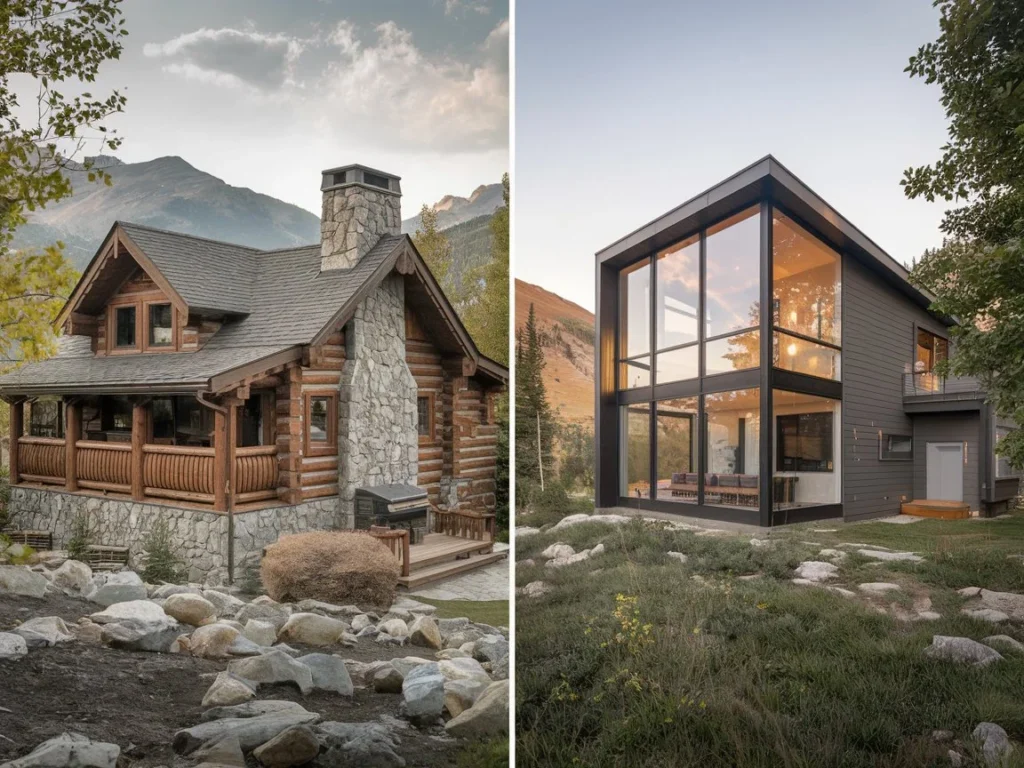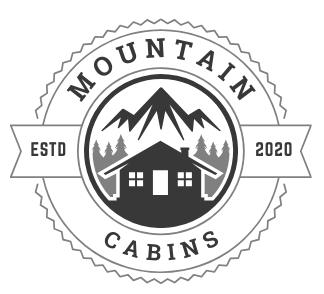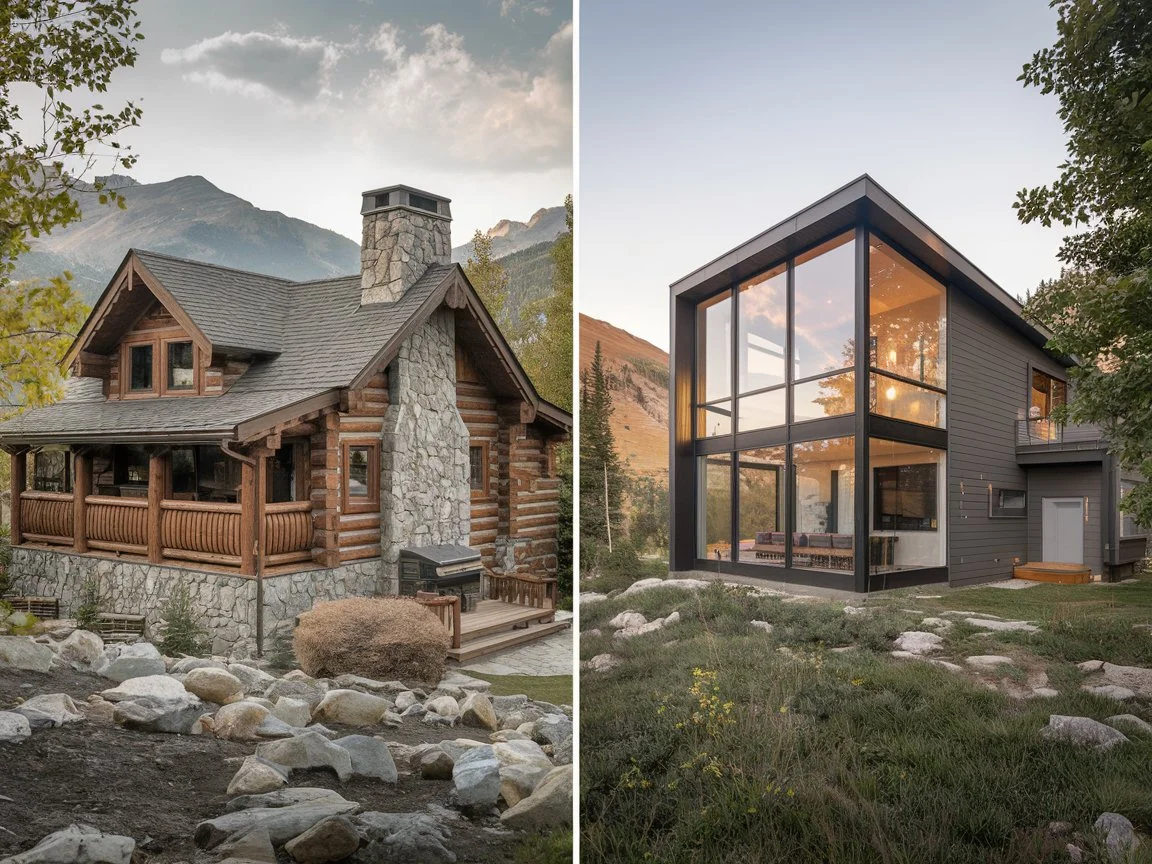
Introduction
The charm of mountain cabins has captivated homeowners and vacationers for generations. Whether used as a getaway retreat or a permanent residence, cabins offer a unique blend of comfort, nature, and rustic appeal. However, with evolving architectural styles, cabins today can range from the timeless charm of traditional log structures to sleek, modern designs that embrace minimalist aesthetics.
Choosing between modern and traditional cabin architecture involves considering personal preferences, lifestyle, budget, and environmental factors. This guide will explore the key characteristics of both styles, their differences, and how to determine the best fit for your needs. Additionally, we will discuss hybrid designs that merge traditional warmth with contemporary sophistication.
Defining Traditional Cabin Architecture
Traditional cabin architecture draws inspiration from historical log cabins and timber-framed homes. Rooted in craftsmanship and natural materials, these cabins exude warmth, comfort, and a deep connection to nature.
Log Cabins & Timber Frame Homes
One of the most recognizable features of traditional cabins is their log or timber frame construction. These homes utilize thick wooden logs, often hand-hewn, to create a sturdy, insulating structure. Timber frame cabins use large wooden beams joined by intricate joinery, showcasing old-world craftsmanship.
Gabled Roofs & Exposed Beams
Gabled roofs are a hallmark of traditional cabins, designed to shed heavy snowfall in mountainous regions. The exposed beams inside create a cozy atmosphere while maintaining structural integrity.
Natural Materials
Traditional cabins prioritize natural materials such as wood, stone, and handcrafted details. Reclaimed wood flooring, stone fireplaces, and handcrafted cabinetry contribute to the rustic aesthetic, making the space feel warm and inviting.
Understanding Modern Cabin Architecture
In contrast to the classic appeal of traditional cabins, modern cabin architecture embraces simplicity, open spaces, and cutting-edge materials.
Minimalist Aesthetic
Modern cabins focus on clean lines and simplicity. They often feature open-concept designs that create a seamless flow between indoor and outdoor spaces, offering a more contemporary and spacious feel.
Large Glass Windows
One of the defining features of modern cabins is expansive glass windows. Floor-to-ceiling windows allow ample natural light and provide panoramic views of the surrounding landscape, enhancing the connection between indoor and outdoor living.
Steel, Concrete & Sustainable Materials
Unlike traditional cabins that rely heavily on wood, modern cabins incorporate materials like steel, concrete, and recycled elements. Many modern cabins also prioritize sustainability with energy-efficient designs, solar panels, and eco-friendly insulation materials.
Key Differences Between Modern & Traditional Cabins
When deciding between modern and traditional cabin architecture, several factors set them apart:
Exterior Design
Traditional cabins feature log or timber exteriors with intricate details, while modern cabins lean towards minimalist facades with smooth, sleek materials.
Interior Layouts
Traditional cabins often have defined rooms and cozy compartments, emphasizing warmth and privacy. In contrast, modern cabins embrace open floor plans, making spaces feel larger and more connected.
Energy Efficiency & Sustainability
Modern cabins tend to be more energy-efficient due to their use of sustainable materials, smart home technologies, and better insulation techniques. Traditional cabins, while durable, may require additional modifications to improve energy efficiency.
Learn more about energy-efficient cabin designs in our guide on Sustainable Cabin Living
Choosing the Right Style for Your Needs
Selecting between a modern or traditional cabin depends on several key factors:
Personal Preference & Lifestyle Considerations
If you appreciate a cozy, rustic environment with historic charm, a traditional cabin may be the right choice. However, if you prefer a sleek, minimalist retreat with contemporary comforts, a modern cabin is more suitable.
Budget & Construction Costs
Traditional cabins often require more natural materials and labor-intensive craftsmanship, which can be costly. Modern cabins, while sometimes expensive due to high-tech materials, may offer cost savings through energy-efficient designs.
Location & Climate Adaptability
Traditional cabins with their thick logs provide excellent insulation in cold climates, while modern cabins, with their advanced insulation techniques, perform well in a variety of weather conditions.
Hybrid Cabin Designs: Blending the Best of Both Worlds
For those who cannot decide between modern and traditional aesthetics, hybrid cabins offer a perfect middle ground.
Mixing Rustic & Contemporary Elements
Hybrid designs combine the warmth of wood with the sleekness of glass and steel. This blend creates a space that feels both timeless and innovative.
Using Traditional Materials with a Modern Twist
Many hybrid cabins use traditional materials like reclaimed wood but incorporate modern architectural elements such as asymmetrical designs and open floor plans.
Popular Hybrid Cabin Examples & Design Inspirations
Some of the most sought-after hybrid cabins feature:
- Log exteriors with floor-to-ceiling glass windows
- Traditional stone fireplaces paired with minimalist interiors
- Open-concept kitchens with exposed wooden beams
Explore stunning hybrid cabin designs in Architectural Digest’s guide
Conclusion
Both modern and traditional cabin architectures have unique advantages. Traditional cabins exude warmth and historical charm, while modern cabins offer sleek aesthetics and contemporary functionality. Ultimately, the best choice depends on your lifestyle, budget, and design preferences.
For those who want the best of both worlds, hybrid designs offer an exciting way to blend rustic elements with modern sophistication. Whether you seek a cozy retreat deep in the woods or a contemporary escape with breathtaking views, a well-designed cabin will always be a place of relaxation and inspiration.
Explor more at Wallpaper – Contemporary cabins for modern minimalists

